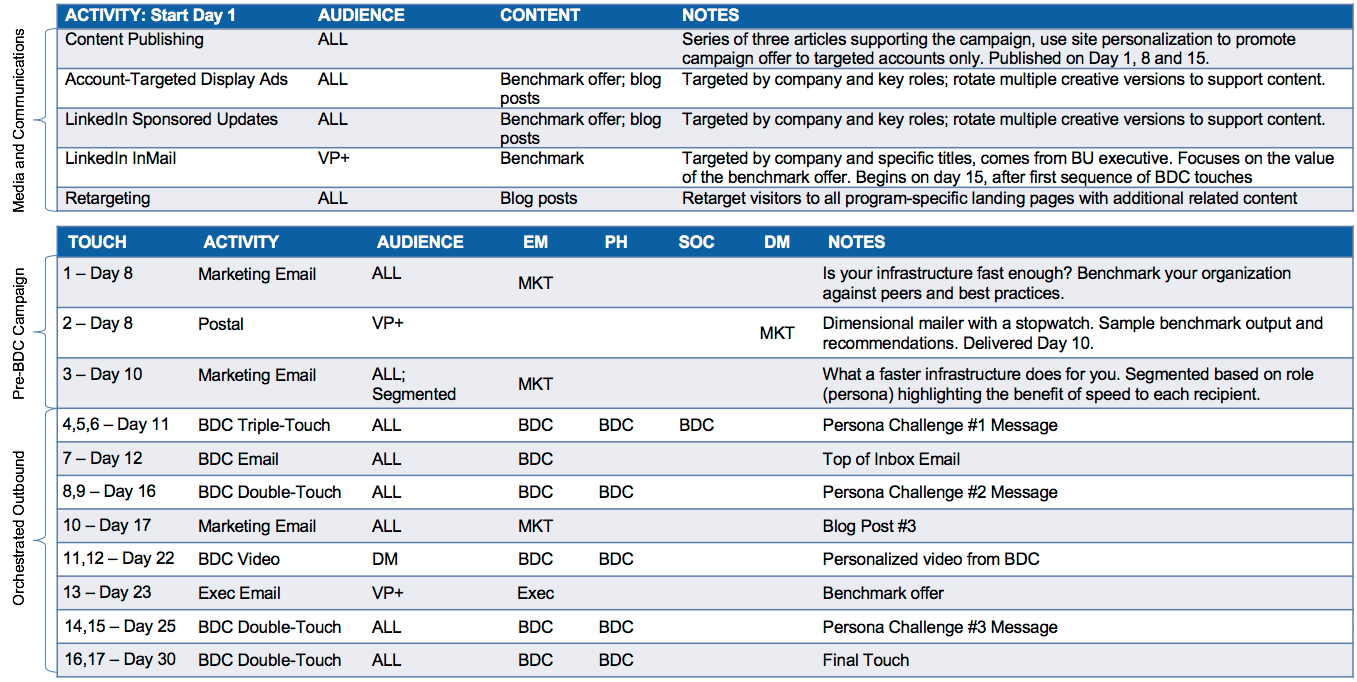After selecting accounts to pursue, you should now develop an orchestration plan that defines both the internal resources responsible for completing specific actions, AND when those actions should be taken against a campaign or account. The plan gives everyone a guide for executing the complex, multi-channel, cross-discipline interactions that occur with an account- based strategy.
Without an orchestration plan, marketing, sales development, and sales teams plan and execute piecemeal account strategies that frequently conflict with one another, and stall progress in prospective accounts.
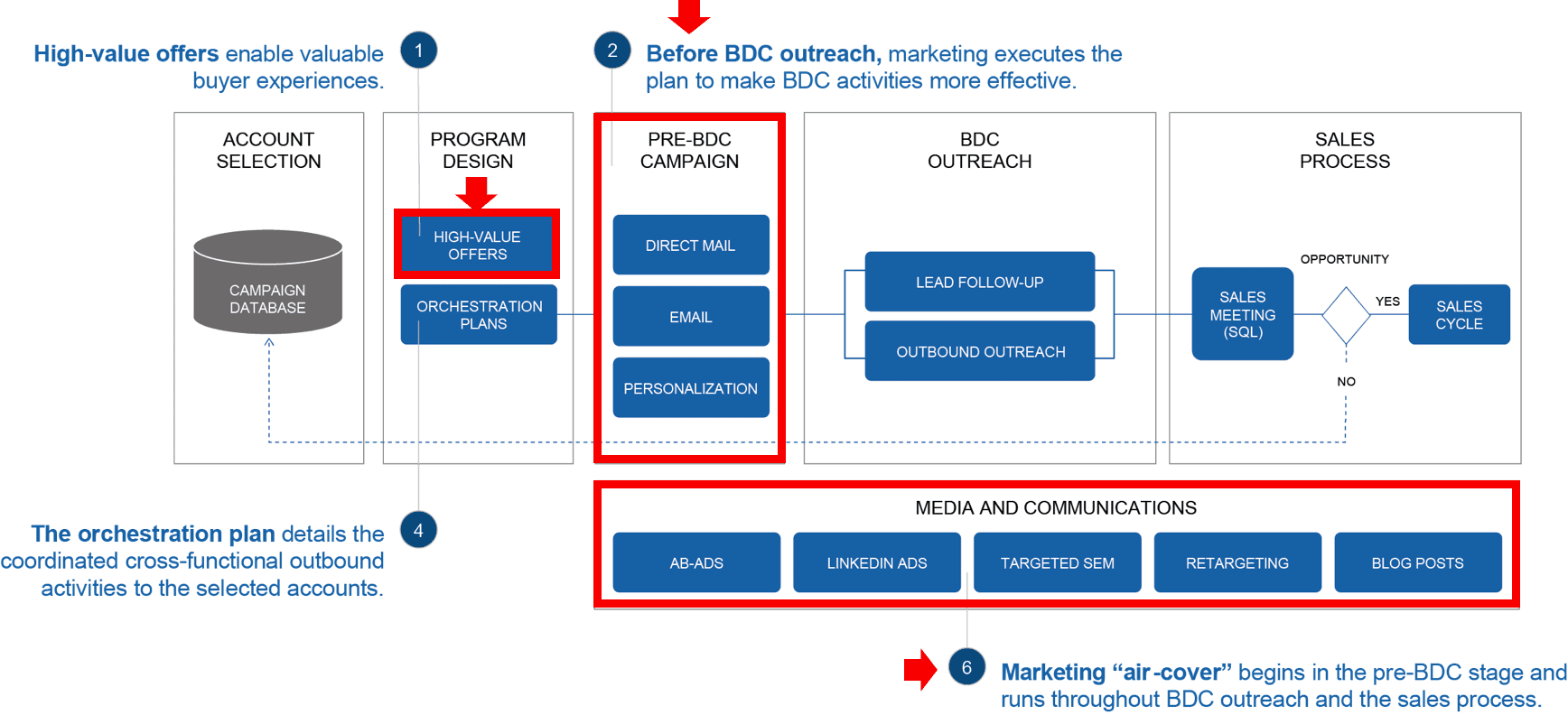
QUICK START PROCESS
| STEP | DESCRIPTION | DELIVERABLE | RESOURCES |
|---|---|---|---|
| 1. | Identify potential high-value offers | A list of offers that meet audience needs and deliver a relevant and personalized perspective | High-Value Offer Framework Example: High-Value Offers |
| 2. | Create the orchestration brief | A completed orchestration brief | |
| 5. | Develop the Pre-BDC campaign | A defined step-by-step series of 1:1 marketing touches designed to increase the effectiveness of BDC activities. Top channels are direct mail and email. | Example: Pre-BDC Campaign |
| 6. | Develop the media and communications plan (“air-cover”) | Often called the “air-cover” plan, this plan begins one week before the pre-BDC plan and provides broader reach and visibility throughout the entire orchestrated plan | Example: Media and Communications Plan |
| 7. | Develop the orchestrated outbound program | The BDC-assigned accounts, scripts and touch patterns for proactive BDC outbound outreach | See the BDC Orchestration section for specific information |
| 8. | Develop the touch pattern | A completed list of BDC touches that will occur during the campaign, including the type and timing of each touch | |
| 9. | Build touch pattern templates and scripts | A complete set of templates and scripts for BDCs to use when executing the touch pattern, with markers for inserting customization points in the templates. | |
| 10. | Consolidate Marketing and BDC plans into one overall orchestration plan | A combined list of all the touches will occur during the campaign, including the type and timing of each touch to be done by marketing and BDCs. | Example: Consolidated Orchestration Plan |
| 11. | Train BDCs on the orchestration plan | Training that teaches the BDCs how to complete the research and customize the templates and scripts in the touch pattern. |
DEVELOPING THE MARKETING ORCHESTRATION PLAN
Begin orchestration with selected accounts and develop a specific program designed to deliver the desired results within the selected accounts vs. beginning with a campaign, developing content, and then sending to many accounts.

HIGH-VALUE OFFERS
High-value offers are at the heart of most successful account-based programs. When the audience sees the value in these offers, it compels them to respond and engage with the organization.
The high-value offer framework provides a way to identify high-value offers by aligning to the business driver and information need of the audience. Examples of additional offers that can be used to drive engagement through marketing and BDC outreach are included below and can be used to expand the offer set.
High-Value Offer’s Goal Is to Improve the Effectiveness of Sales’ Outreach First and Foremost

“Of all the channels for getting content to prospects, salespeople are still the best.”
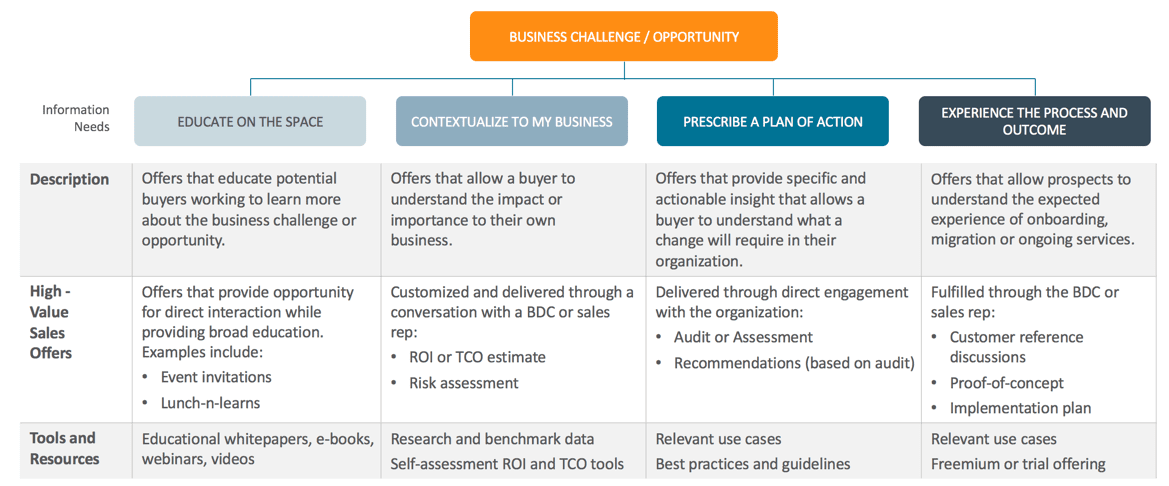
“Many of the most successful programs deliver information for BDCs to follow-up on.”
CREATE THE ORCHESTRATION BRIEF
The orchestration brief aligns the team on the purpose, resources, and audience of the orchestration plan. Use the tool below to create an effective orchestration briefing. Refer to the guidance below for specific sections of the orchestration brief.
The orchestration brief builds on information developed in earlier stages of program planning. The following parts of the orchestration brief are the most likely to need additional information:
-
The Objective: Each orchestration plan has a unique, measurable outcome and moves the account through some small number of steps.
-
The Value Proposition (of the offer): Not to be confused with the value proposition of your product, this shows how the offer, be it a piece of content or a meeting, is the best way for a potential buyer to spend their time.
-
The Audience Insight: The team developing the orchestration plan must understand the audience insights that tie to the offer and the value proposition described above, which will be a subset of the overall audience insights available.
-
Expected Outcomes and Measurement: The plan for measuring the program against expected outcomes. Measurement will come primarily from Account-Based Dashboards.
DEVELOP THE PRE-BDC CAMPAIGN
The pre-BDC elements of the program are executed primarily by marketing and lean heavily on traditional marketing activities. The emphasis on a call-to-action and on direct response metrics is reduced; these activities are designed instead to improve the effectiveness of BDC outreach first and foremost.
The Pre-BDC Campaign
The pre-BDC campaign begins 3 days to one week before BDC outreach begins. The pre-BDC campaign delivers content, such as a sample analysis, or other information illustrating the value of the BDC offer. A pre-BDC cadence uses direct mail and email as the primary channels, many of the most successful programs deliver information for BDCs to follow up on.
DEVELOP THE MEDIA & COMMUNICATIONS PLAN
The Media and Communications (or “air cover”) element begins three days to one week before the first pre-BDC touch and runs throughout the program. The air-cover program relies on traditional media activities, including digital display, social advertising, search, and PR to engage the audience and reinforce the overall message of the program.
Many elements of the air-cover program are targeted to the individuals or accounts included in the orchestrated plan, providing a significant presence against the selected accounts while minimizing the required program media investment.
SALES ORCHESTRATION
Account-based Business Development Consultants (BDCs) form a specialized team focused on prospecting for new opportunities in selected ideal customer profile (ICP) accounts. Create an outbound orchestration plan that concentrates the BDC outbound efforts on the high-value offer to just the selected accounts vs. follow-up on all accounts with generic value prop messaging.
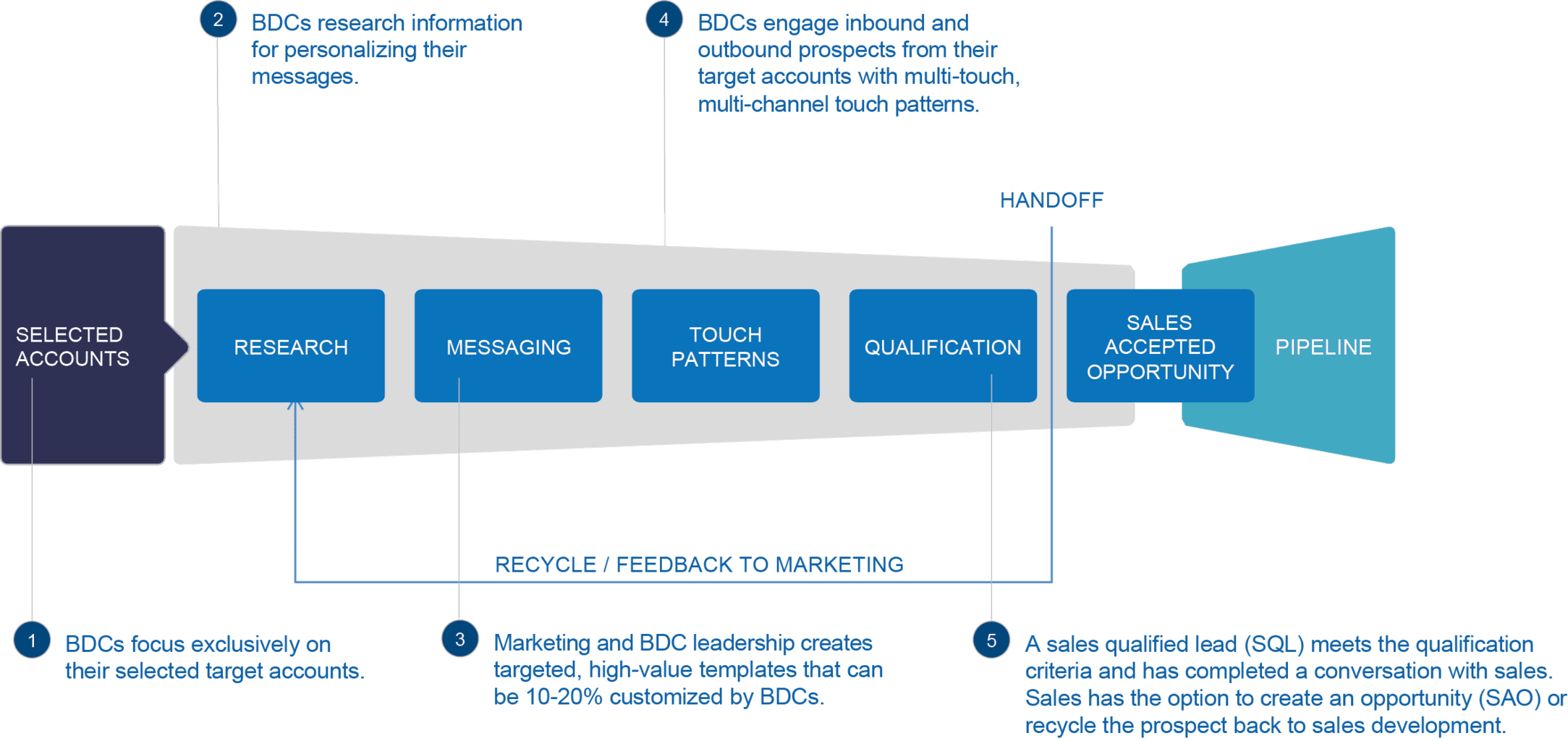
DEVELOP THE TOUCH PATTERN
Create a detailed list defining the BDCs’ actions and the subject or theme for customizing the touches. Every touch pattern indicates the timing, subject, and action required to execute each touch.
EXAMPLE: ORACLE ACCOUNT-BASED TOUCH PATTERN
MESSAGE DEVELOPMENT
Once research has surfaced a relevant insight, the BDCs create, in one session, the touch messaging for the entire touch pattern.
| COMPONENT | MESSAGING FRAMEWORK | EMAIL BUILDER |
|---|---|---|
| Subject Line | Highlight the challenge or value prop mentioned in the email. | “[Summarize value statement]” |
| Create Context | Lead with your reason for reaching out, making it relevant to setting up the offer. | “Hi [name], I wanted to share with you how we are helping some of your peers address [insert persona challenge]“ |
| Convey Value | Create compelling value statements, in alignment with the campaign, that demonstrate how you address one of the buyer’s challenges. | “Specifically, I’d like to tell you how we’ve helped [peer customer #1 and peer customer #2] solve this challenge and others and how we’ve helped them [insert key benefit]” |
| Deliver Offer | Close with a call-to-action that sets up a high-value offer that correlates to the campaign. | “I’d like 15 minutes of your time to share more about these use cases, as well as other ways we are helping [persona] achieve success. How does [time option 1] or [time option 2] work for you?” |
EMAIL EXAMPLE 1

EMAIL EXAMPLE 2
EXAMPLE: CALENDAR INVITE HANDOFF TEMPLATE
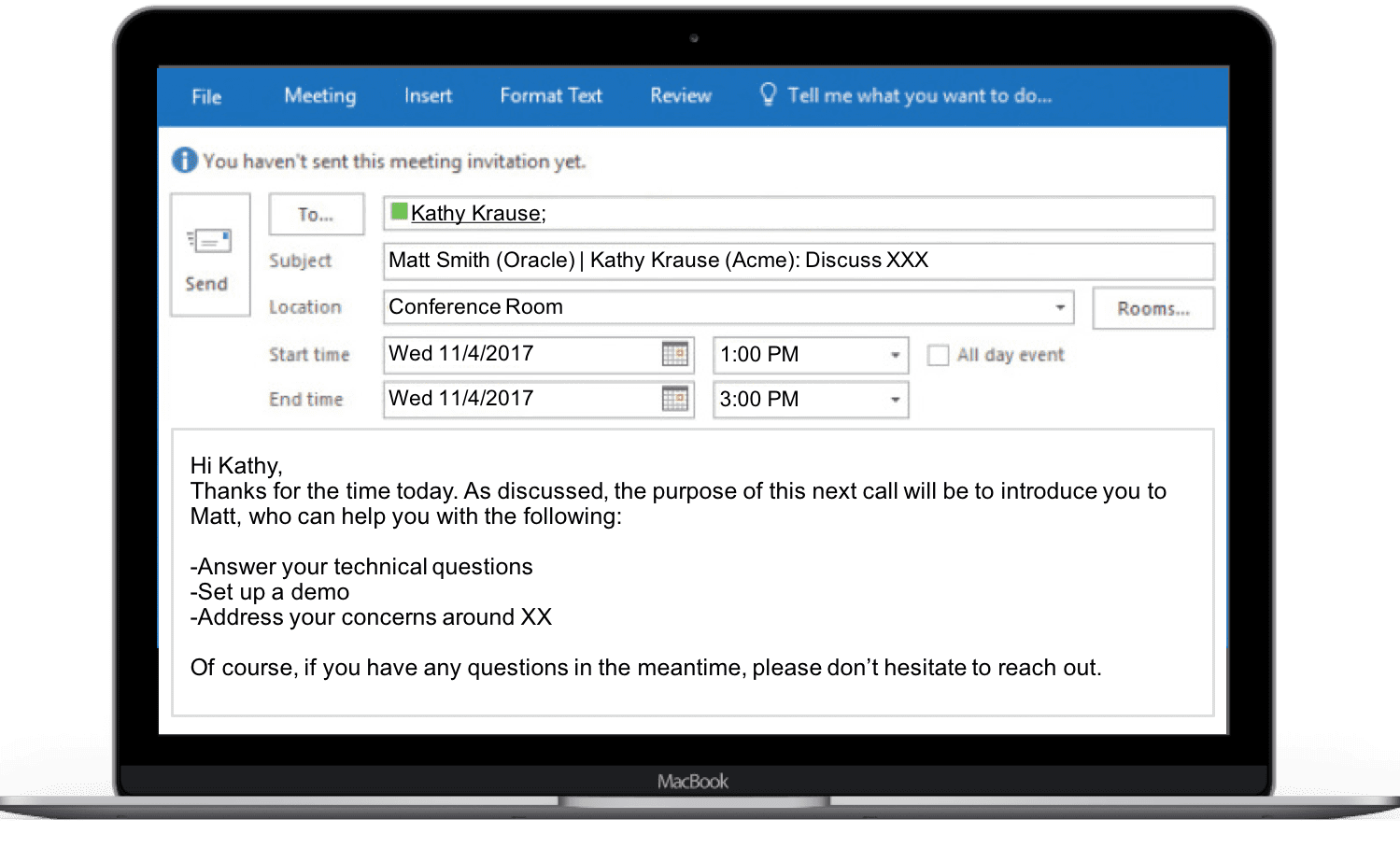
To complete the handoff:
- Send the calendar invite with the “handoff template” introducing the prospect to the sales rep.
- Set up a call with the sales rep to debrief the qualification conversation.
- Enter all notes into Oracle Sales Cloud for the sales rep to reference.
CONSOLIDATE MARKETING AND BDC TOUCHES INTO OVERALL ORCHESTRATION PLAN
READINESS ASSESSMENT
| COMPONENT | EVALUATION CRITERIA | |
|---|---|---|
| 1. | High-value offer(s) identified | Are the offers designed to deliver additional value to a potential buyer through a BDR or sales rep conversation? |
| 2. | Outbound orchestration | Does the outbound account campaign involve coordinated steps for both marketing and BDRs for every contact? |
| 3. | BDC touches follows high-value marketing campaign | Is the first BDC touche scheduled within three days of the highest-impact follows high-value marketing campaign |
| 4. | Messaging | Do the BDC Touch Pattern templates create context for the touch and position the value of the offer to the prospect based on buyer challenges and benefits? |
| 5. | Coordination | Does the outbound account campaign involve coordinated steps for both marketing and BDCs for every contact? |
| 6. | Timing | Does the first BDC touch occur within three days of pre-BDC touch, and then every 2-4 days until the end of the campaign? |
Send your Account-Based questions to kelvin.gee@oracle.com




